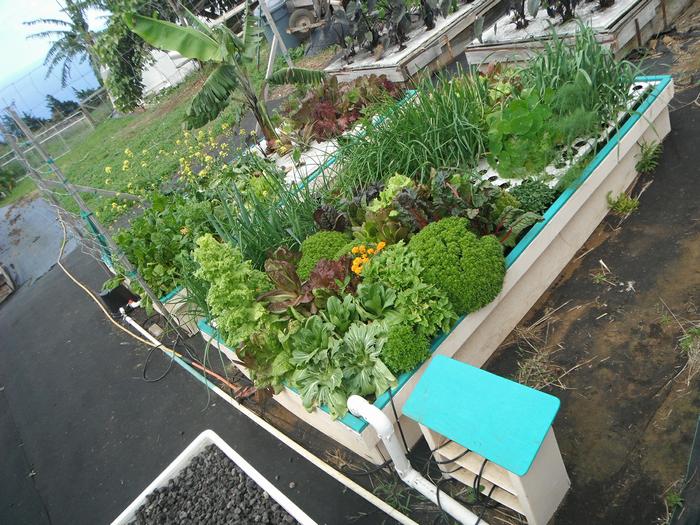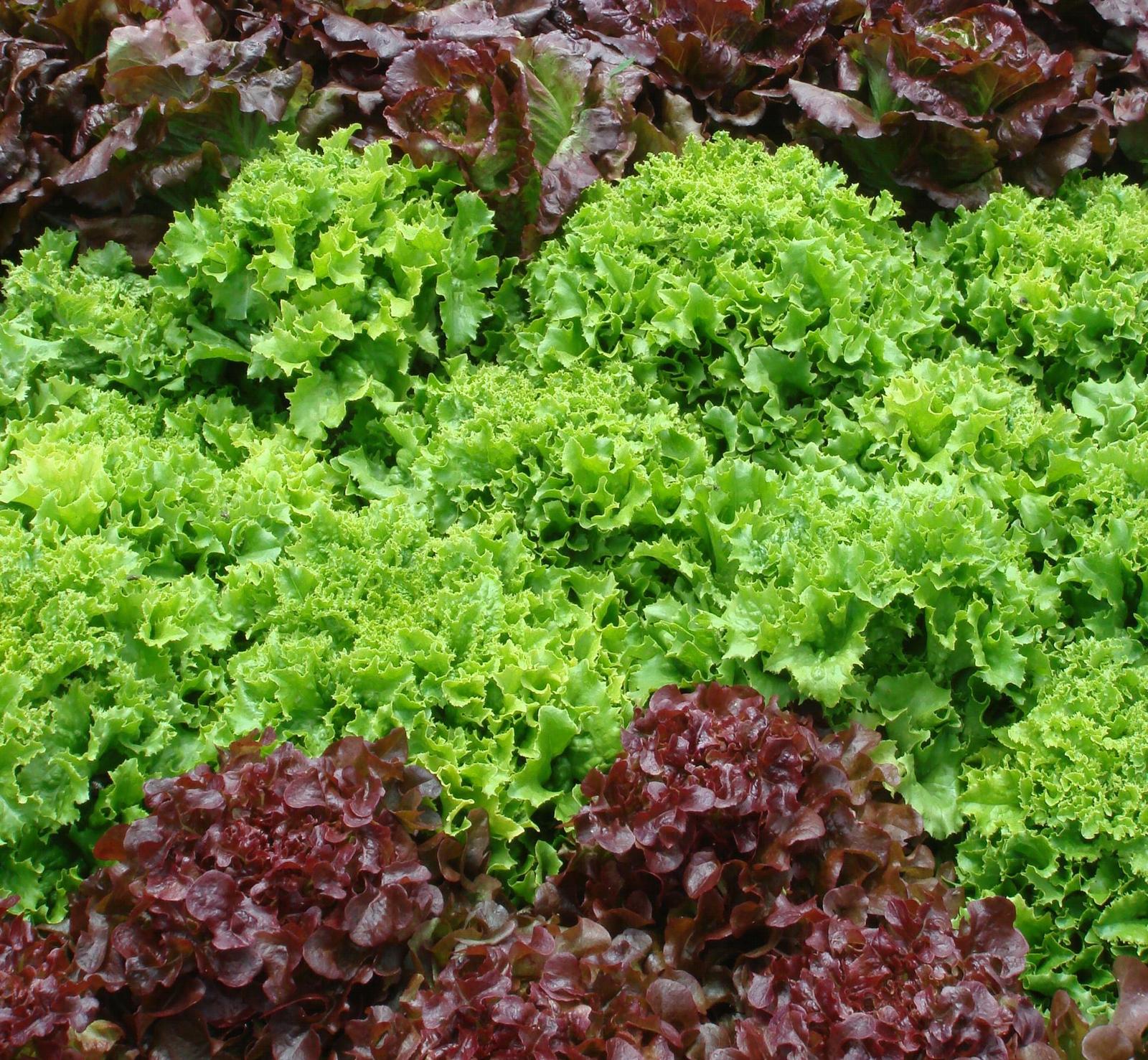Doing Your Test Grows, or “How Do I Know What To Grow?”
You can’t make money with aquaponics if you grow the wrong things. Not everything will earn you the same return, and guessing is deadly. Especially guessing how much you’re going to get per head or per pound for a particular item. Good aquaponics systems grow vegetables like wild, but if you grow the wrong vegetable, you won’t make a profit.
Example: in our 5,000 square feet of aquaponics system, we can harvest about 800 pounds per week of high-quality organic head lettuce. But we only get $2 per pound for it, or $1,600 gross. If we harvest it a little earlier to get smaller “spring mix” leaves we would only get 600 pounds a week; but we’d get from $6 to $9 per pound for it when rinsed, dried, and packed in nice biodegradable individual bags. This is a gross income of $3,600 to $5,400 per week. Not bad, right?
(Below) A Micro System 64 in full bloom during a Test Grow; I can pick out 21 different species of plants. Can you find the banana tree and the pineapple plant? Can you identify the three species that are going to seed? (We sometimes collect our own seeds, too).
We could grow about 2,000 pounds per week of Napa cabbage in the same area instead. On the face of it, this sounds like it might be a better deal; we’d have 1,400 pounds more produce to sell. But when you analyze the market for organic Napa cabbage in our location, you find that you only get $0.79 per pound for it.
This is $1,600 per week; with slightly lower expenses than we had for the $3,600 to $5,400 worth of lettuce spring mix. Selling the 800 lbs of head lettuce for $1,600 gross would be a better deal than the Napa cabbage for $1,600 gross, because we’d only have to harvest, pack, and move 800 pounds of lettuce instead of 2,000 of cabbage!
It’s obvious which is the best deal for us, though: the spring mix, with a gross of $3,600 to $5,400 per week! Where did we get this information? We did preliminary market research, then test grew and test marketed the head lettuce, the lettuce spring mix, and the Napa cabbage to determine how much our yields were, how long our “cycle times” were, how much labor was involved, and how much the market could take.
What To Grow:
You will know what to grow for profit after you’ve completed your preliminary market analysis and have also done a number of “test grows” in your area. Why is it necessary to do a test grow? Can’t you just select things from the “Planting Trials” section of the manual and be successful growing them in your location? No! Even with all our experience, we couldn’t do that!
We can’t predict which varieties of which species will grow well in your location. This is because things will grow differently in your location from other locations. All the following things affect plant growth, and they all change your results when your location changes even slightly: your average amount of sunlight, your day and nighttime temperatures, your humidity, your knowledge and experience level, and your particular greenhouse or climate-control systems. This holds true even if you’re using our exact system designs with no changes!
A grower who lives just down the street from you will get different results; this is why some farmers who enter the County Fair contests win, and others from the same area don’t even come close. So how do you determine what to do? Do several test grows, then test market with the produce from the test grows.
If you want to build your commercial aquaponics installation now, and choose what to plant it out in without doing any test grows, OK. But we warned you: we know of four large commercial aquaponics failures that invested $350,000 to $1,400,000 and lost it all. None of them bothered to do test grows first to determine yields, labor costs, and cycle times (addressed next). These failures are cited in the slideshow titled “Commercial Aquaponic Failures.pptx” that accompanies this manual; we do not want an opportunity to add your business to it as a case study in the future.
One of the things your your preliminary market analysis will show you is that lettuce is a high-value crop. This is because growing lettuce in the soil is incredibly labor-intensive and it is also difficult to produce a high-quality product. It’s much less work in aquaponics, and the quality is two or three times what soil-grown lettuce has. So we have a suggestion: grow lettuce for money (that is, the varieties your test grow showed you were best) your first year while you continue to do test grows with your Micro System.
Growing lettuce is relatively easy money; and by the time a whole bunch of other aquaponics growers come on the market in your area, you will have figured out how to grow a bunch of other crops too, and can move on to the most profitable of them. Your first year is always a cash crunch, and lettuce is a guaranteed income crop for which we’ve worked out all the bugs. Just follow the “High Density Planting Techniques For Greens” section of the manual; it explains how to grow the best lettuce in the world in excruciating detail.
How To Do A Test Grow:
Do a “preliminary market survey” first. This is simple; just cruise the organic produce section of your nearest grocery stores, and write down the produce prices in a list. Average out the prices, then compare this list to the “Planting Trials” section of this manual; this will give you a starting point to order seeds for your test grow from. If there’s an item with a high local price that the Planting Trials said grew well, get some seeds and try it. If the Planting Trials said it grew poorly, but it’s a high-value crop, maybe you should still try it, because we know things will grow differently in your area.
Micro System Ideal For Conducting Test Grows
Our 64 or 128 square foot Micro Systems are ideal for doing test grows; you got the plans and manual when you bought this manual. The 64 has 412 plant spaces, and the 128 has 824 spaces; you can try a number of different varieties and species. You’ll need all the normal supplies for growing: slit pots, potting mix ingredients of coir and vermiculite, seeds, and nursery trays to hold the pots.
You will also need the following special items so you are able to accurately track all the information you will obtain: a scale that can read to within a hundredth of a pound; plastic plant tags so you can tag each batch of seeds planted with the species, variety, and date planted; and special markers called “Garden Markers” for marking the plant tags with. These have ultraviolet filters in the ink so it won’t fade, and are environmentally friendly.
Why Bother With A Test Grow?
The four large recent commercial aquaponics failures we just referred to that invested $350,000 to $1,400,000 and lost it all is why. None of them bothered with test grows first to determine yields, market pricing, labor costs, and cycle times (addressed next), nor did they try out their chosen aquaponics technology first at a small scale to see if it was profitable.
They just “went for it”, as we say in Hawaii. “Go for it!” is a surfing term (“went for it” is past tense), and means “paddle hard and catch the wave!”. The problem with going for it comes when you do so without the necessary experience and skill level. You often end up “going over the falls” on your wave. We surfers also call this “being in the washing machine”, and yes, it’s as bad as it sounds! Use your imagination when extrapolating this technique to a new business that has your money and time involved!
Specifics Of Doing A Great Test Grow
We’ll assume you’re conducting this test grow in a reasonably mature Micro System, because if you do this during the “startup” period, everybody knows you may experience slight nitrogen deficiencies which will skew your results. Wait until your startup is over and things are growing well before you do your first serious, well-documented test grow.
We’ll further assume you purchased seeds for the produce items with the highest local prices, that you know will grow in aquaponics systems (check in Planting Trials, with 150+ varieties of plants we’ve grown in aquaponics to get an idea where to start). You planted these seeds according to directions in the proper potting mix, have watered them properly to germinate them, have germinated them in optimum conditions (see Germination Section of this manual). What now?
Wait, feed the fish, and check ammonia and pH once a week. Your test grows will take from 28 to 90 days, depending on many factors: species and variety of plant, amount of sunlight received, air and aquaponic water temperatures, adequate protection from nighttime cold temperatures, protection from too much sun in the summer, and so on.
Documenting Your Test Grow:
When you planted the seeds, you recorded the species, seed variety and planting date on plastic plant tags with a “Garden Marker”, then stuck the tag (or three tags, so you don’t lose them all if one blows away!) into the pots in the nursery tray you put the newly seeded plants into. These tags accompany the plants during the whole test grow, so you don’t mistakenly mix up plants. The only thing worse than having something grow poorly is to have something grow really well and have no idea what it is!
If you’ve lost the plant tags and don’t know what that awesomely productive variety is, the only recourse you have is to order your entire last seed order all over again, replant, and wait a month to three months to figure out what’s what. Only this time we bet you’ll remember to tag your plants! This is why using plant tags and keeping them with the correct set of plants all the way to harvest is critical!
(Below) Dang! Those plant tags must be in there somewhere!
For Your Second And Subsequent Test Grows:
After your first test grow, you will have an idea what grows well out of the crops you selected. However, you couldn’t try everything in the seed catalog in the limited area of your Micro System, so you only planted certain things: what you considered your “best bet”. It is a really good idea to go back during your second and subsequent test grows, and plant at least three or four varieties of each vegetable type you’re considering, especially if it didn’t do well in the first test grow.
Here’s why: we’ve found that one or two varieties of a vegetable will do quite well in our specific location, one or two will do poorly, and the others in between somewhere. If we accidentally select the one that grows poorly when we’re ordering seeds, and don’t ever try the others, we’re running the chance that we will conclude that “so-and-so doesn’t grow well”, and miss a bet, when what really happened is that we just picked the wrong one.
Awesome! I love learning something new and I do everytime I read your newsletter. I like the new look, by the way.